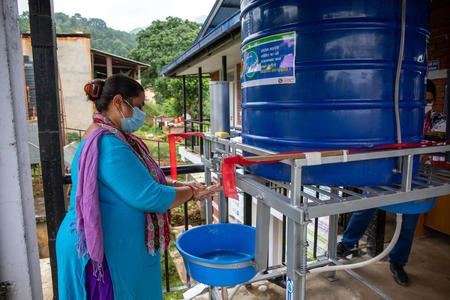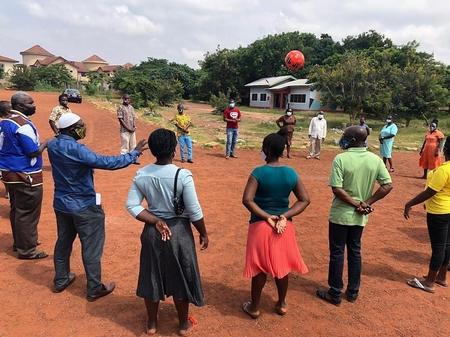Hand hygiene: crucial to control COVID-19 and prevent future pandemics

Handwashing with soap is the first line of defence against COVID-19, and vital to preventing the spread of many other diseases that burden global health. Om Prasad Gautam, Senior WASH Manager – Hygiene at WaterAid UK, discusses the importance of hand hygiene to curb COVID-19 and prevent future pandemics.
This is a Global Handwashing Day like no other. The COVID-19 pandemic has highlighted on a truly global scale the critical role of hand hygiene in preventing and reducing the spread of diseases. For 2020, this day dedicated to advocating handwashing with soap for health, policy and strategy change, and greater prioritisation of and investment in sustainable development programmes has assumed even greater importance.
One of the most cost-effective public health interventions, hygiene – more specifically, hand hygiene – has been a first line of defence against COVID-19, helping to save millions of lives around the world. While handwashing remains at the forefront of public health and awareness, we must take this opportunity to act together to change people’s hygiene behaviours, for a generation and on a massive scale.
This year, under the theme of ‘Hand Hygiene for All’, we are celebrating hand hygiene as a central part of the COVID-19 response and development programming. We are urging prioritisation of long-term, sustainable behaviour change programmes at all levels, to curb COVID-19, prevent other communicable diseases including diarrhoeal diseases, and avert future pandemics.
How is hand hygiene linked to COVID-19?
COVID-19 is primarily transmitted via respiratory droplets and contact routes, via close contact with infected individuals, coughing and sneezing. As well as direct contact, droplets can land on hands, objects or surfaces around the person, exposing others to the virus if they touch those objects then touch their eyes, nose or mouth, or use contaminated hands for eating. Soap destroys the outer membrane of the virus, de-activating it and preventing the spread.
Handwashing with soap prevents disease outbreaks and pandemics
Lack of good hand hygiene practices enables disease transmission and outbreaks, keeping children from school, stopping adults from working, putting more vulnerable people in hospital, and putting institutions such as schools and healthcare facilities at risk of being centres of infection. Simple handwashing with soap is linked with:
- up to 30–48% reduction in risk of endemic diarrhoea (reference 1, ref. 2, ref. 3)
- up to 23% reduction in acute respiratory infections
- up to 50% reduction in pneumonia
- substantial reduction in neonatal infections
- 27% reduction in infection-related infant deaths through improved handwashing practices in healthcare facilities, and a further 40% by handwashing in the postnatal period
- 43% (fewer days) reduced school absenteeism
- preventing healthcare-associated infections
- 36% reduced personal risk of seasonal coronavirus infection
Rigorous hygiene, including handwashing, is crucial in reducing transmission of outbreak-related pathogens; it helps prevent the spread of cholera, Ebola, shigellosis, SARS, hepatitis E, neglected tropical diseases and COVID-19.
Hand hygiene is a cost-effective intervention
Handwashing with soap is one of the most cost-effective public health interventions in reducing the global infectious diseases burden, costing just US$3 per disability-adjusted life year (DALY) averted.
Various studies suggest that reductions in diarrhoeal diseases and acute respiratory infections resulting from behaviour change programmes aimed at handwashing with soap can bring large economic gains – for example, $5.6 billion net return in India ($23 per DALY averted), and $2.6 billion return ($22 per DALY averted) in China. The Australian National Hand Hygiene Initiative was found to be cost-effective against an Australian threshold of AUS$42,000 per life-year gained.
Making handwashing part of development programmes is therefore a cost-effective way to reduce the disease burden, prevent current and future pandemics and help reach the many Sustainable Development Goals to which it is crucial.
Why has hand hygiene remained poor?
Lack of facilities and habits
Globally, 40% of households don’t have handwashing facilities with soap and water, and just 19% of people wash their hands with soap after defecating. Although more people may currently be practising good hand hygiene because of their fear of COVID-19, past experience and evidence has shown that this may only be a temporary stimulus.
Similarly, 43% of healthcare facilities don’t have basic handwashing facilities with soap and water at points of care, and 47% of schools in developing countries lack handwashing facilities. That means 900 million students do not have anywhere to wash their hands with soap while at school. Data show huge disparities between low- and high-income settings, and between urban and rural locations. Without facilities, people cannot hope to practise proper hygiene, and their health is at risk.
Lack of sector prioritisation
Despite its cost-effectiveness and high impact on health, hand hygiene was still neglected up until the pandemic. Although recognition of the importance of sustained behaviour change is growing, it is still highly neglected by the WASH (water, sanitation and hygiene), health, education and nutrition sectors. This manifests in knowledge-focused interventions; positioning hygiene as an add-on activity; designing interventions on the basis of expert thinking; siloed implementation of hygiene programmes; a lack of dedicated coordination and financing; and output-focused monitoring mechanisms rather than sustained behaviour change.
Business as usual is not going to be possible in the new normal brought by COVID-19. A massive shift is needed in how hygiene is positioned in ongoing programmes across sectors, and it should be looked at from a systems change perspective.
How can we make hand hygiene interventions effective?
Hand hygiene behaviour change programmes are more likely to be effective if the intervention designs follow a systematic process and are based on behavioural science evidence. It is important to address key behavioural determinants and use people’s emotions, basing specific features on assessments.
It is important to note that the educational method of promoting hand hygiene is not enough – information alone doesn’t lead to sustained hand hygiene behaviour change. Interventions must be designed to be context-specific, inclusive and attractive, motivating people and changing their physical environment to prompt and reinforce behaviours. For example, placing behavioural products such as handwashing facilities with soap and water in key locations makes behaviours easy, and, combined with cues and nudges, causes people to be more likely to practise behaviours.
Interventions should be delivered through the correct institutional mechanism, so built capacities can be retained. And continuous monitoring is essential to understand whether, why and how ongoing programmes are effective, and to adapt them where necessary.
Using experience to prioritise hand hygiene in the COVID-19 response
We have always promoted handwashing with soap as one of the most cost-effective public health interventions in reducing the global burden of infectious diseases. Now we are positioning handwashing, along with other key behaviours, as the first line of defence in curbing the COVID-19 pandemic and protecting people.
We are drawing on our years of experience in implementing at-scale, context-specific behaviour change programmes. Working with governments and through partnerships, using a behaviour-centred, evidence-based approach, we are reaching 99 million people across the countries where we work in South Asia, Africa and Latin America.
To motivate people and adhere to best practice, we are using a range of attractive and emotional behavioural change promotional materials through mass, social and digital media, household visits and other non-contact methods to avoid cross-contamination. These assets used people’s emotions and go beyond awareness raising. Read about examples of our response.
To offer people the immediate opportunity to practise good hygiene, and to limit cross-contamination, we have designed and implemented context-specific, hands-free inclusive handwashing facilities in public places. See our technical guide for handwashing facilities in public locations and institutions for examples. At household level we are promoting locally feasible handwashing solutions.
We use a rights-based approach in everything we do, and focus on reaching marginalised, vulnerable and socially excluded populations. Applying equity and inclusion principles, taking a thorough and systematic approach, and using creativity and evidence enables our programmes to lead to long-term, sustainable behaviour change in communities, even during this challenging time. Read our blog on how to make hygiene responses inclusive.
In the second phase of our response (depending on disease transmission), we will continue to increase community-based campaigns, while maintaining our wider mass media campaigns. With additional funding from partners – including the UK Foreign Commonwealth and Development Office and Unilever as part of the Hygiene Behaviour Change Coalition (HBCC) initiative, various foundations and private sector organisations, and individual givers – we are ramping up our efforts in many countries, scaling the response for long-term sustainable change. And we are making our response progressive, generating and looking at evidence in detail as we go.
Hand hygiene to prevent future pandemics
Sustainable hygiene behaviour change programmes (including hand hygiene) should be integral to any development agenda, including containing COVID-19 and preventing future pandemics. We will continue advocating its importance and demonstrating its impact through our programmes.
We will continue to review and design context-specific, innovative, creative, evidence-based interventions, and to focus on changing key hygiene behaviours to maximise impact and influence policy. We will build the capacities of our stakeholders including governments, partners and staff to design, implement and evaluate robust hygiene programming using the evidence-based Behaviour Centred Design Approach. We will support global and local initiatives towards ‘hand hygiene for all’.
Our strategic partnerships with governments, public institutions, academia, the private sector and civil society support large-scale sustainable hygiene improvements by focusing on strengthening systems, effective sector coordination and financing, while implementing behaviour change programmes. We will urge governments, donors and all relevant sectors to invest in and prioritise hygiene, including hand hygiene.
A COVID-19 vaccine must be paired with hygiene behaviour change programmes
There is often a belief that vaccines are silver bullets. Many initiatives are underway to find a vaccine solution, to which many governments and donors are committing funding. Although a successful vaccine will be an important milestone in the pandemic and save millions of lives and many economies, it is imperative to note that the extent of vaccine efficacy and effectiveness of candidate vaccines is far from certain.
Not all existing vaccines for preventable diseases are 100% efficacious and effective, and few diseases can be completely eradicated. Hygiene therefore remains incredibly important, with or without a vaccine. While funding for vaccines is essential to address the immediate need of this pandemic, future investment should be in ‘vaccine + hygiene’.
Hygiene together with vaccine administration has a cumulative effect in preventing the spread of diseases, including coronaviruses (although more evidence specific to COVID-19 is needed). We have shown the possibilities of integrating hygiene into at nationwide immunisation programmes through our work in Nepal.
A collective, global effort
Designing, implementing and evaluating behaviour change programmes effectively requires a multi-disciplinary approach. Achieving this at scale will need a collective effort from governments, donor agencies, NGOs, community-based organisations, private sector, academia and civil society in the sector.
Achieving sustainable hand hygiene for all requires a step change in transformative yet inclusive behaviour change-focused programmes at scale. We have learned a lot, before and during the COVID-19 pandemic – most importantly, we are still learning. Through robust hygiene behaviour change programmes, including hand hygiene for all initiatives, together we can use handwashing with soap to reduce the spread of the virus, prevent future pandemics and transform global health.
Om Prasad Gautam is Senior WASH Manager – Hygiene at WaterAid UK. Follow him on Twitter at @OmPrasadGautam.







